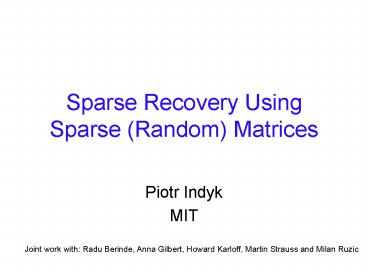Sparse Recovery Using Sparse Random Matrices - PowerPoint PPT Presentation
Title: Sparse Recovery Using Sparse Random Matrices
1
Sparse Recovery Using Sparse (Random) Matrices
- Piotr Indyk
- MIT
Joint work with Radu Berinde, Anna Gilbert,
Howard Karloff, Martin Strauss and Milan Ruzic
2
Goal of this talk
- Stay awake until the end
3
Linear Compression(learning Fourier coeffs,
linear sketching, finite rate of innovation,
compressed sensing...)
- Setup
- Data/signal in n-dimensional space x
- E.g., x is an 1000x1000 image ?
n1000,000 - Goal compress x into a sketch Ax ,
- where A is a m x n sketch matrix, m ltlt n
- Requirements
- Plan A want to recover x from Ax
- Impossible undetermined system of equations
- Plan B want to recover an approximation x of
x - Sparsity parameter k
- Want x such that x-xp? C(k) x-xq
( lp/lq guarantee ) - over all x that are k-sparse (at most k
non-zero entries) - The best x contains k coordinates of x with the
largest abs value - Want
- Good compression (small m)
- Efficient algorithms for encoding and recovery
- Why linear compression ?
4
Linear compression applications
- Data stream algorithms
- (e.g. for network monitoring)
- Efficient increments
- A(x?) Ax A?
- Single pixel camera
- Wakin, Laska, Duarte, Baron, Sarvotham,
Takhar, Kelly, Baraniuk06 - Pooling, Microarray Experiments Kainkaryam,
Woolf, Hassibi et al, Dai-Sheikh, Milenkovic,
Baraniuk
5
Constructing matrix A
- Choose encoding matrix A at random
- (the algorithms for recovering x are more
complex) - Sparse matrices
- Data stream algorithms
- Coding theory (LDPCs)
- Dense matrices
- Compressed sensing
- Complexity/learning theory
- (Fourier matrices)
- Traditional tradeoffs
- Sparse computationally more efficient, explicit
- Dense shorter sketches
- Goal the best of both worlds
6
Prior and New Results
7
Prior and New Results
Excellent
Scale
Very Good
Good
Fair
8
Recovery in principle (when is a matrix good)
9
dense vs. sparse
- Restricted Isometry Property (RIP) - sufficient
property of a dense matrix A - ? is k-sparse ? ?2? A?2 ? C ?2
- Holds w.h.p. for
- Random Gaussian/Bernoulli mO(k log (n/k))
- Random Fourier mO(k logO(1) n)
- Consider random m x n 0-1 matrices with d ones
per column - Do they satisfy RIP ?
- No, unless m?(k2) Chandar07
- However, they can satisfy the following RIP-1
property Berinde-Gilbert-Indyk-Karloff-Strauss08
- ? is k-sparse ? d (1-?) ?1? A?1 ?
d?1 - Sufficient (and necessary) condition the
underlying graph is a - ( k, d(1-?/2) )-expander
Other (weaker) conditions exist, e.g., kernel
of A is a near-Euclidean subspace of l1. More
later.
10
Expanders
- A bipartite graph is a (k,d(1-?))-expander if for
any left set S, Sk, we have N(S)(1-?)d S - Constructions
- Randomized mO(k log (n/k))
- Explicit mk quasipolylog n
- Plenty of applications in computer science,
coding theory etc. - In particular, LDPC-like techniques yield good
algorithms for exactly k-sparse vectors x - Xu-Hassibi07, Indyk08, Jafarpour-Xu-Hassibi-Ca
lderbank08
N(S)
d
S
m
n
11
Proof d(1-?/2)-expansion ? RIP-1
- Want to show that for any k-sparse ? we have
- d (1-?) ?1? A ?1 ? d?1
- RHS inequality holds for any ?
- LHS inequality
- W.l.o.g. assume
- ?1 ?k ?k1 ?n0
- Consider the edges e(i,j) in a lexicographic
order - For each edge e(i,j) define r(e) s.t.
- r(e)-1 if there exists an edge (i,j)lt(i,j)
- r(e)1 if there is no such edge
- Claim 1 A?1 ?e(i,j) ?ire
- Claim 2 ?e(i,j) ?ire (1-?) d?1
d
m
n
12
Recovery algorithms
13
Matching Pursuit(s)
A
x-x
Ax-Ax
i
i
- Iterative algorithm given current approximation
x - Find (possibly several) i s. t. Ai correlates
with Ax-Ax . This yields i and z s. t. - xzei-xp ltlt x - xp
- Update x
- Sparsify x (keep only k largest entries)
- Repeat
- Norms
- p2 CoSaMP, SP, IHT etc (dense matrices)
- p1 SMP, this paper (sparse matrices)
- p0 LDPC bit flipping (sparse matrices)
14
Sequential Sparse Matching Pursuit
- Algorithm
- x0
- Repeat T times
- Repeat SO(k) times
- Find i and z that minimize A(xzei)-b1
- x xzei
- Sparsify x
- (set all but k largest entries of x to 0)
- Similar to SMP, but updates done sequentially
A
i
N(i)
Ax-Ax
x-x
Set zmedian (Ax-Ax)N(i) . Instead, one
could first optimize (gradient) i and then z
Fuchs09
15
SSMP Running time
- Algorithm
- x0
- Repeat T times
- For each i1n compute zi that achieves
- Diminz A(xzei)-b1
- and store Di in a heap
- Repeat SO(k) times
- Pick i,z that yield the best gain
- Update x xzei
- Recompute and store Di for all i such that
- N(i) and N(i) intersect
- Sparsify x
- (set all but k largest entries of x to 0)
- Running time
- T n(dlog n) k nd/md (dlog n)
- T n(dlog n) nd (dlog n) T nd (dlog
n)
A
i
Ax-Ax
x-x
16
SSMP Approximation guarantee
- Want to find k-sparse x that minimizes x-x1
- By RIP1, this is approximately the same as
minimizing Ax-Ax1 - Need to show we can do it greedily
17
Experiments
256x256
SSMP is ran with S10000,T20. SMP is ran for 100
iterations. Matrix sparsity is d8.
18
Conclusions
- Even better algorithms for sparse approximation
(using sparse matrices) - State of the art can do 2 out of 3
- Near-linear encoding/decoding
- O(k log (n/k)) measurements
- Approximation guarantee with respect to L2/L1
norm - Questions
- 3 out of 3 ?
- Kernel of A is a near-Euclidean subspace of l1
Kashin et al - Constructions of sparse A exist
Guruswami-Lee-Razborov, Guruswami-Lee-Wigderson - Challenge match the optimal measurement bound
- Explicit constructions
Thanks!
This talk































